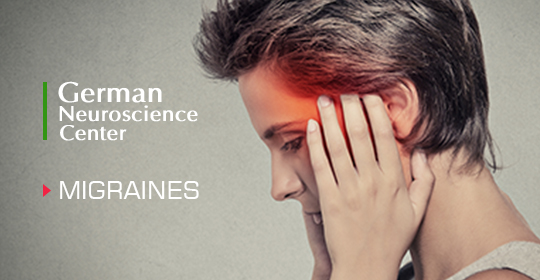
Migraines: Causes, Symptoms, and Treatment
Migraines are the most common neurological headache disorders with a projected global prevalence of 15%. A migraine can cause intense throbbing pain or a pulsating sensation, usually on one side of the head, that is generally followed by nausea, vomiting, and extreme sensitivity to sound and light. Typically, migraine attacks can last for a few hours to days, and they are more common in females than males between the ages of 15 to 55 years.
For some people, the onset of a migraine attack can start with pre-migraine symptoms or an aura of sensory disturbances followed by a severe headache, commonly affecting one side of the head. A migraine aura can consist of visual disturbances such as flashes of light or blind spots and other symptoms such as a tingling sensation in the arms, legs, or one side of the face and speech difficulty. However, medication can help prevent and manage some forms of migraines and make them less incapacitating.
What Causes Migraines
The exact cause of migraine remains a mystery, but it is purported to be a result of temporary changes in the chemicals, blood vessels and nerves located in the brain. Moreover, about half of the people affected by this condition have a close relative who experiences migraines, which suggests that genes also plays a role.
However, for some people, migraine attacks result from specific triggers, including:
- Emotional triggers: Stress, anxiety, depression, shock, or excitement may trigger a migraine.
- Hormonal changes: Women can experience migraine symptoms during menstruation due to the fluctuation of hormones.
- Medications: Some sleeping pills, combined contraceptive pills, and hormone replacement therapy (HRT) may trigger attacks.
- Physical causes: fatigue, lack of adequate sleep, poor posture, low blood sugar, and tension in the neck or shoulder are also triggers.
- Diet: Alcoholic and caffeinated drinks and foods such as cheese, chocolate, citrus fruits, among others, can contribute to triggering attacks.
- Environmental triggers: Strong odors, flickering lights, loud noise, bright lights are also possible triggers.
What are the Signs & Symptoms of Migraines?
Early signs and symptoms of migraine usually start in childhood or adolescence levels and progress through four stages, including:
- Prodrome
This stage begins 24hours typically before a migraine. The beginning symptoms of migraine in this stage include:
- Constipation
- Food cravings
- Sudden mood changes, ranging from depression to euphoria
- Neck stiffness
- Uncontrollable yawning
- Increased fluid retention
- Frequent urination
- Aura
Depending on a person, this stage may occur before or during a migraine. Migraine aura is a reversible symptoms of the nervous system that usually starts gradually, progresses within minutes and lasts for 20 minutes to one hour. Some symptoms associated with aura include:
- Vision loss
- Difficulty speaking
- Pins and needles sensations in the arms and legs
- Numbness in the face or one side of the body
- Visual phenomena such as seeing bright spots, various shapes, zig-zag lines and flashes of flight
- Uncontrollable twitching or other movements
- Attack/headache
Typically, the frequency of migraines varies between people, buts usually last for 4 to 72 hours without treatment. The attack begins gradually and then becomes severe causing a throbbing or pulsating pain on one side of your head. Other common symptoms in this stage include:
- Sensitivity to noise, light, and odors
- Nausea and vomiting
- Pain that worsens when you sneeze, cough or move
- Post-drome
During this stage, common symptoms include exhaustion, confusion or weakness. These symptoms can last up to a day.
Types of Migraines
Migraines are classified into two categories depending on whether the individual experiences pre-migraine symptoms or sensory disturbances climaxing into a migraine. These include:
- Migraines with aura: These types of migraines provide warning signs known as aura, as already mentioned above.
- Migraines without aura: These are the most common types of migraines. These attacks offer no prior warnings or sensory disturbances.
While these are the two main types of migraines, there are others which are associated with specific disorders or triggers, such as:
- Chronic migraine: This refers to any attack that lasts for more than 15 days within a given month.
- Menstrual migraine: In this case, attacks are associated with patterns of the menstrual cycle.
- Hemiplegic migraine: These attacks cause temporary weakness on one side of the body.
- Abdominal migraine: This is a common type of migraine, usually affecting children under the age of 14 years. In this case, attacks are triggered by irregular functions in the gut and abdomen.
- Migraine with brainstem aura: This is an uncommon type that causes severe neurological symptoms such as affected speech.
Migraine Treatment
There is no definite cure for this condition, but treatment options aim to reduce the severity of attacks and alleviate the symptoms that follow. Treatment options range from lifestyle changes to use of drugs, and surgery for severe migraines.
- Healthy lifestyle changes
Healthy lifestyle modifications consist of getting adequate sleep, minimizing stress, drinking plenty of water, exercising, and eating a healthy trigger-free diet. However, if this approach doesn’t offer relief for your symptoms, consider other treatment approaches.
- Medication
Various types of migraine medication can be used to treat and manage this condition, including pain relief drugs. Most drugs are readily available over the counter (OTC) and should be taken early in the headway of a migraine. Some of these include:
- Naproxen
- Ibuprofen
- Aspirin with caffeine
For more severe cases of migraine, special anti-migraine medication is used very effectively, such as triptans.
In some people, migraines are accompanied by other symptoms such as vomiting and nausea. As such Metoclopramide and Serotonin may be used for those cases.
Furthermore, preventive therapy is very effective to decrease frequency, pain intensity and duration of migraine headaches as well as improve the effectiveness of other treatment approaches may be used.
Moreover BOTOX injections are used in patients whose conditions fail to respond to first-line treatment.
When to see a doctor
Although migraines may remain undiagnosed and untreated, you should immediately see your doctor or go to an emergency room if you experience:
- Changes in your headaches
- Confusion, fever, seizures, neck stiffness, affected speech or double vision
- Worsening headache after a fall or injury to the head
- A sudden, severe headache
- A chronic headache that worsens with sudden movement or coughing
Call us today and book your appointment at the German Neuroscience Center.

